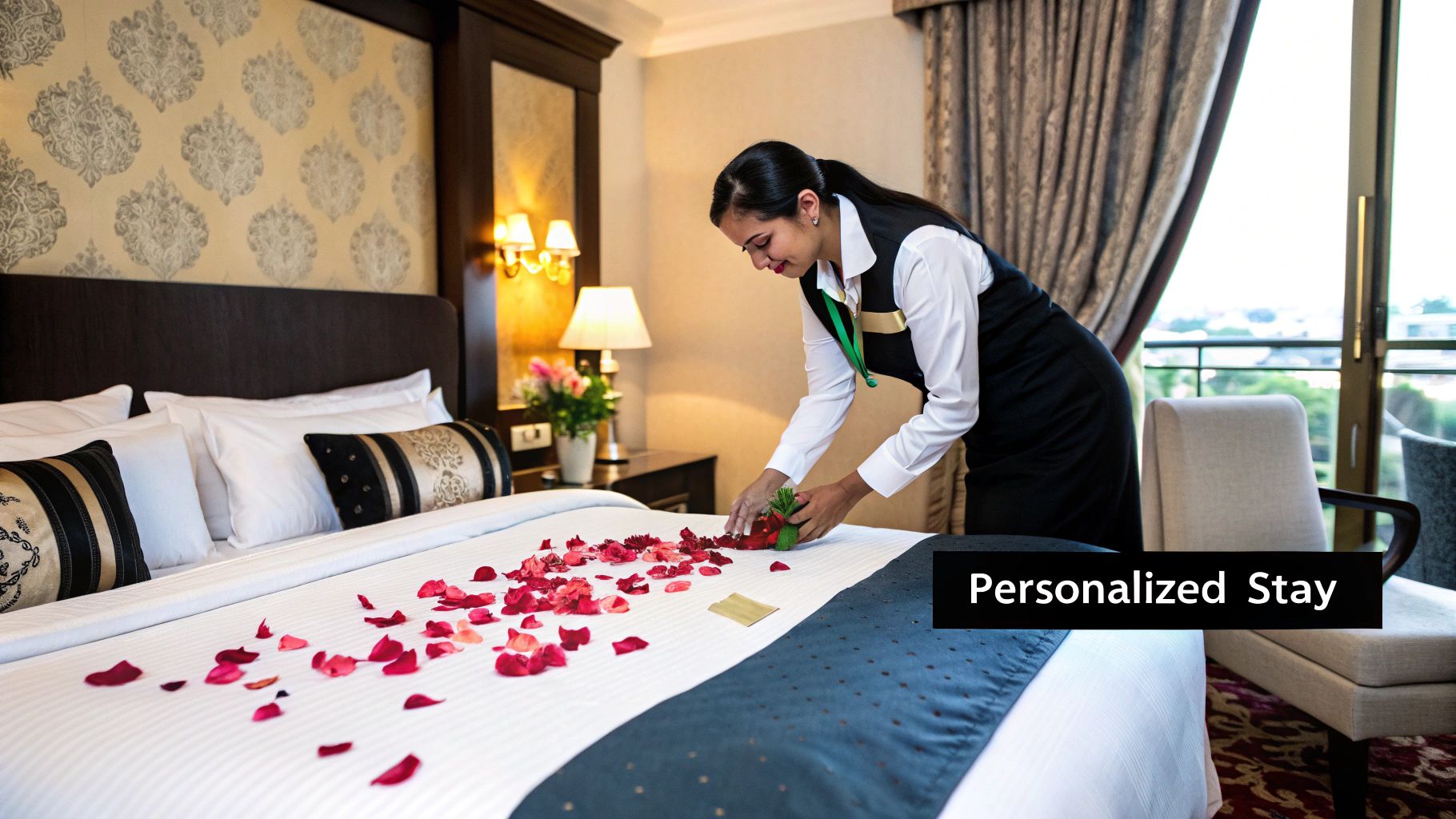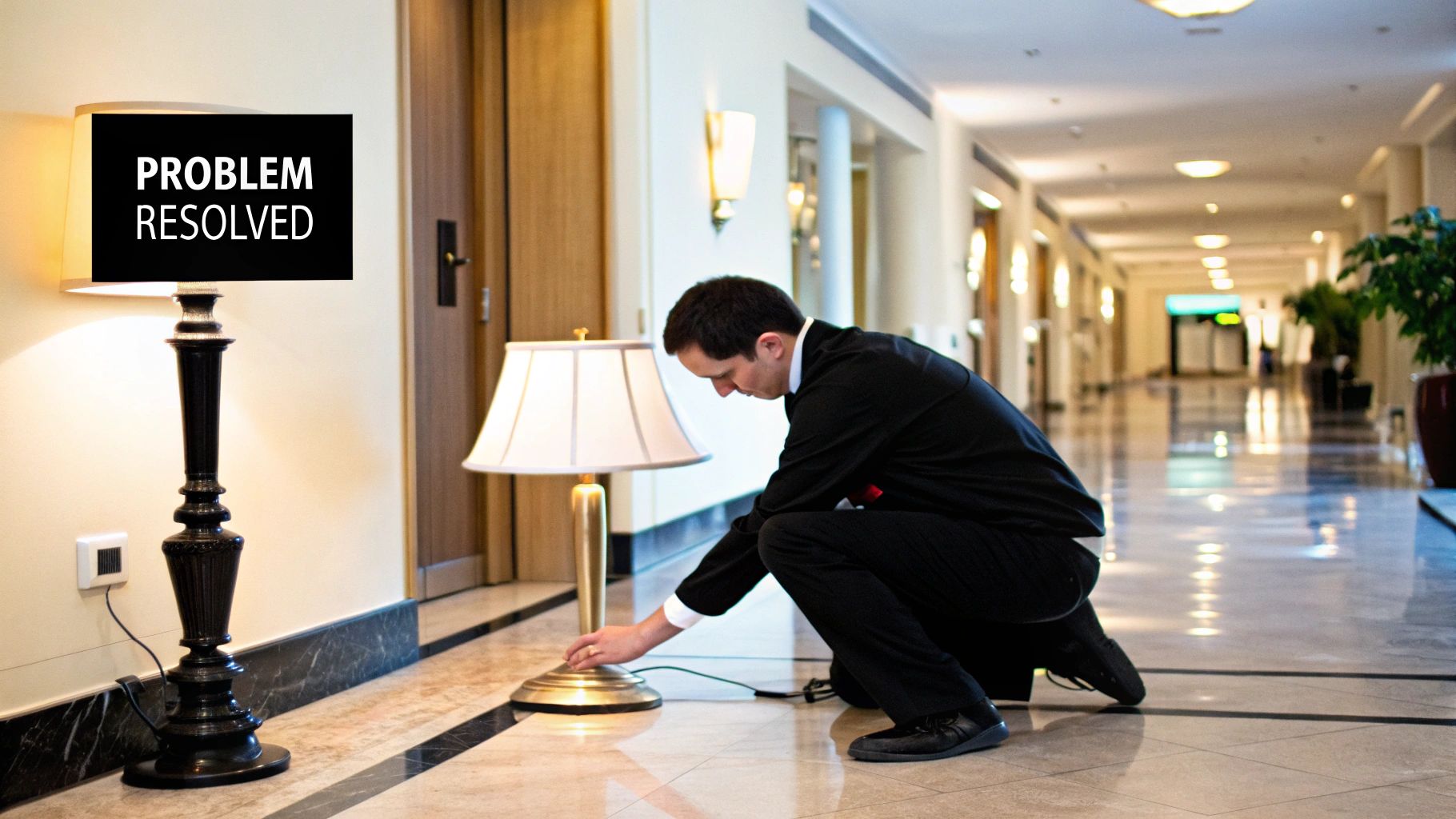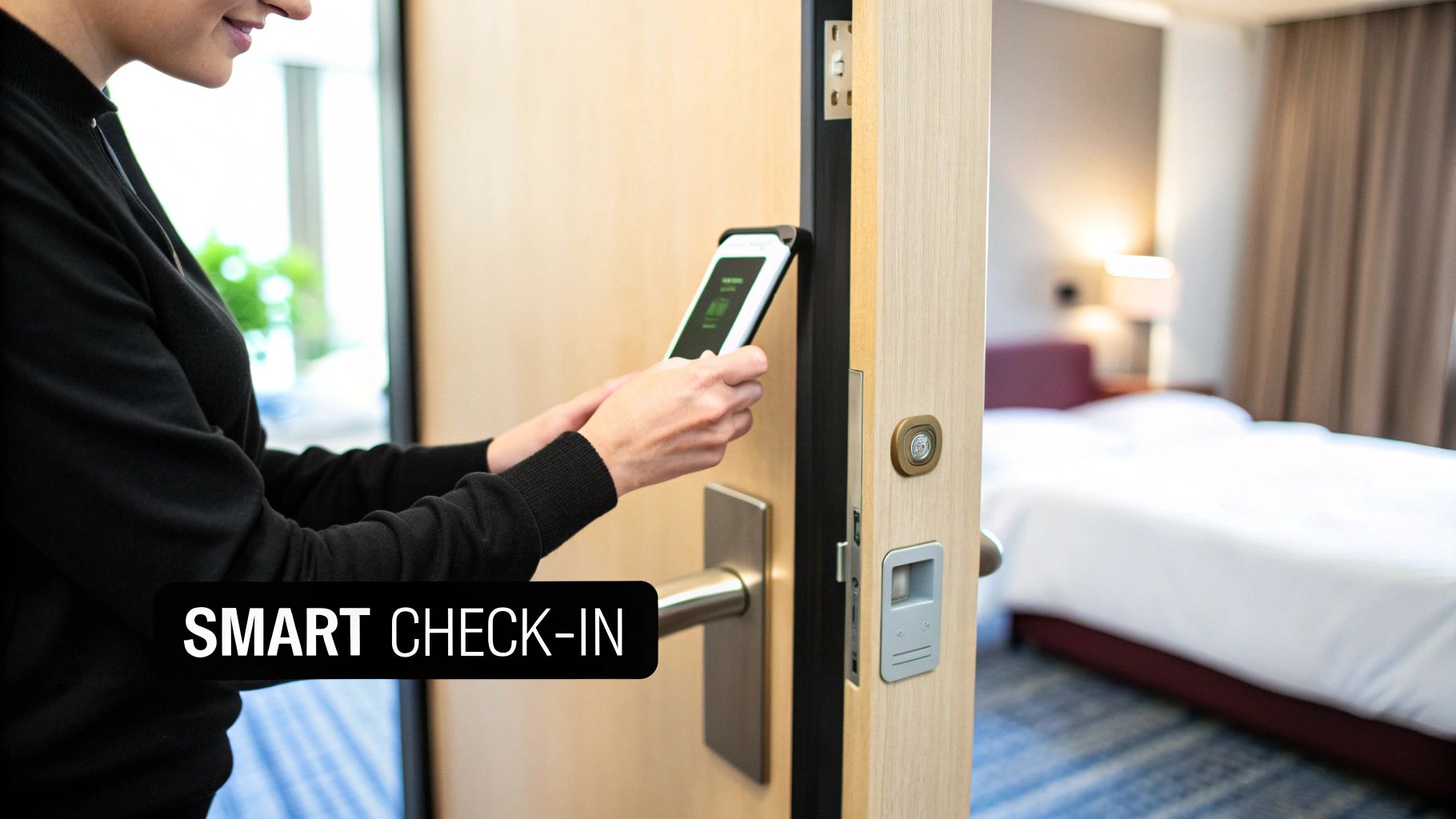In today’s competitive hospitality and residential market, simply meeting expectations is no longer enough. The key to unlocking higher net operating income (NOI), fostering loyalty, and generating stellar reviews lies in one core mission: to improve guest satisfaction. But achieving this requires more than just excellent service; it demands a strategic infusion of technology. This guide moves beyond generic advice, offering a deep dive into powerful, technology-driven strategies that are reshaping the guest journey.
To lay a strong foundation, the new blueprint for exceptional guest experiences must incorporate powerful customer engagement strategies that foster lasting relationships. We will explore how to integrate these concepts with operational excellence.
From AI-driven personalization and proactive problem resolution to a seamless omnichannel communication plan, we’ll provide actionable blueprints that operators can implement immediately. These aren’t just trends; they are foundational pillars for creating memorable stays, streamlining operations, and building a reputation for excellence. Get ready to explore the specific, practical methods for delivering the five-star experience modern guests and residents expect, securing your property’s success for 2025 and beyond.
1. Personalized Service and Customization
Personalized service is the art of tailoring amenities, communications, and experiences to individual guest preferences, transforming a standard stay into a memorable one. This strategy moves beyond generic hospitality to create unique, curated visits that foster deep loyalty and significantly improve guest satisfaction. By leveraging guest data, you can anticipate needs and deliver customized touchpoints that demonstrate genuine care and attention to detail.

This approach is exemplified by luxury brands like Ritz-Carlton, which famously maintains guest preference profiles to track everything from a guest’s preferred pillow type to their favorite newspaper, ensuring a consistent, personalized experience across all its properties. Similarly, top-tier Airbnb hosts often provide welcome baskets with local treats based on a guest’s stated interests or provide a hand-curated list of restaurant recommendations that match their culinary tastes.
How to Implement a Personalization Strategy
Successfully implementing this requires a systematic approach to collecting and utilizing guest information.
- Gather Data Proactively: Start collecting preference data during the booking process. Simple questions about the reason for their visit (e.g., business, anniversary, family vacation) can provide immediate opportunities for customization.
- Utilize a Centralized System: To achieve truly personalized service, leveraging robust CRM platforms is essential. For instance, exploring Salesforce CRM solutions can provide powerful tools for understanding guest preferences and tailoring experiences. Integrating this system with your property management system is crucial. Learn more about the benefits of integrating your PMS for enhanced guest experiences.
- Empower Your Staff: Train your team to not only access this data but also to actively listen and observe. A front desk agent who remembers a guest’s name or a housekeeper who notices a preference for extra towels adds a powerful human touch that technology alone cannot replicate.
- Follow Up and Refine: After a stay, send personalized follow-up emails requesting feedback. Use this information to refine the guest’s profile for their next visit, creating a cycle of continuous improvement.
2. Proactive Problem Resolution
Proactive problem resolution is the strategic practice of identifying and addressing potential issues before they impact the guest experience. It involves creating systems to anticipate problems and empowering staff to provide immediate, effective solutions when issues do arise, turning a potential negative into a memorable moment of exceptional service. This approach is fundamental to improve guest satisfaction by showing guests that their comfort and convenience are a top priority, often before they even realize a problem exists.

This philosophy is championed by industry leaders like Marriott, whose “Spirit to Serve” program authorizes employees to resolve guest complaints on the spot. Another powerful example is Southwest Airlines, which proactively rebooks passengers on new flights during weather delays, often before customers have a chance to call. Similarly, Disney’s renowned Guest Relations teams are trained to identify and address park issues, from a lost item to a disappointing ride experience, preventing minor frustrations from escalating.
How to Implement a Proactive Resolution Strategy
Executing this strategy requires shifting from a reactive mindset to a preventative one, supported by clear processes and a positive organizational culture.
- Empower Frontline Staff: Give your team the authority to make decisions. Establish clear, reasonable spending limits (e.g., up to 0 for a complimentary meal or room credit) that front desk agents or managers can use to immediately rectify a problem without needing higher approval. This autonomy is key to a swift and satisfactory resolution.
- Create a “No-Fault” Reporting Culture: Encourage employees to report potential issues, from a flickering lightbulb to a slow Wi-Fi signal, without fear of blame. Reward staff for identifying problems early, as this helps prevent them from affecting future guests. This approach turns every team member into a quality assurance agent.
- Schedule Preventative Maintenance: Implement a rigorous, regularly scheduled maintenance program for all equipment and facilities, from HVAC systems to in-room appliances. Use a digital checklist system to track inspections and repairs, ensuring that you fix problems before they cause a breakdown and a guest complaint.
- Document and Analyze Incidents: Maintain a detailed log of all guest-reported issues and their resolutions. Regularly review this data to identify recurring problems, which can signal a deeper systemic issue that needs to be addressed at its root, ultimately leading to a better overall guest experience.
3. Omnichannel Communication Strategy
An omnichannel communication strategy is a comprehensive approach that ensures seamless, consistent, and interconnected interactions across all guest touchpoints. This method integrates phone, email, live chat, social media, and mobile apps, allowing guests to communicate through their preferred channel without losing context. Adopting this strategy is vital to improve guest satisfaction by making your team accessible and responsive whenever and wherever a guest needs assistance.

This unified experience is perfectly illustrated by Hilton’s mobile app, which allows guests to check in, select their room, and chat directly with the front desk, all within a single platform. Similarly, Airbnb’s unified messaging system ensures that all communication between hosts and guests is centralized, creating a clear and accessible record. This prevents information from getting lost and ensures both parties have a consistent line of communication from booking to checkout.
How to Implement an Omnichannel Strategy
Building a successful omnichannel framework requires the right technology and a well-trained team to manage guest interactions effectively.
- Invest in an Integrated Platform: Adopt a unified communications platform or customer service software that consolidates all channels into a single dashboard. This gives your staff a complete view of a guest’s interaction history, regardless of the channel used.
- Establish Consistent Service Standards: Define and maintain clear standards for response times and service quality across all channels. A guest should receive the same high level of care whether they send an SMS, an email, or a message on social media.
- Leverage AI with a Human Touch: Implement AI-powered chatbots to provide instant answers to common questions 24/7. However, it’s crucial to ensure a smooth and easy handoff to a human agent for more complex or sensitive issues.
- Train Your Staff Thoroughly: Your team must be proficient in using the integrated platform and understand the importance of maintaining a consistent brand voice. Cross-training staff on different channels ensures they can provide support where it’s needed most, enhancing efficiency and guest satisfaction.
4. Employee Training and Empowerment
Employee training and empowerment is a foundational strategy that directly links staff capabilities and morale to guest experiences. This approach recognizes that technology and amenities are only as effective as the people who manage them. By investing in comprehensive training and granting employees the authority to make decisions, you create a motivated team capable of delivering consistently exceptional service, which is a cornerstone to improve guest satisfaction.

This philosophy is famously championed by Horst Schulze of Ritz-Carlton, whose “Gold Standards” training empowers every employee to spend up to $2,000 per guest to resolve an issue without seeking management approval. Similarly, the customer-obsessed culture at Zappos, popularized by Tony Hsieh, involves extensive initial training and encourages service representatives to spend as much time as needed on the phone to delight a customer, moving beyond scripts to build genuine connections.
How to Implement an Empowerment Strategy
A successful program requires a clear framework that gives staff both the skills and the confidence to act.
- Create Detailed Service Standards: Document your expectations for every guest interaction, from check-in to check-out. This manual becomes the foundation for all training and ensures a consistent brand experience.
- Establish Clear Boundaries for Authority: Clearly define the scope of an employee’s decision-making power. Knowing they can offer a complimentary breakfast or a room upgrade to solve a problem without fear of reprisal encourages proactive problem-solving.
- Implement Continuous Training: Conduct regular training sessions that include role-playing common and uncommon guest scenarios. This builds practical skills and prepares staff for real-world challenges, boosting their confidence and competence.
- Foster a Supportive Culture: Encourage a culture where employees are recognized and rewarded for taking initiative to improve guest satisfaction. Implement mentorship programs to pair new hires with experienced staff, accelerating their development and integration into your service philosophy.
5. Technology-Enhanced Guest Experience
A technology-enhanced guest experience involves leveraging modern digital solutions to streamline interactions, boost convenience, and improve guest satisfaction. This strategy integrates innovations like mobile apps, contactless services, Internet of Things (IoT) devices, and AI-powered assistance directly into the guest journey. By automating and simplifying processes, you can deliver a seamless, modern stay that meets the expectations of today’s tech-savvy travelers.
This approach is prominently featured by industry leaders like Marriott International, whose mobile app allows for keyless room entry and service requests directly from a smartphone. Similarly, Amazon’s Alexa for Business has been integrated into hotel rooms to control lighting, temperature, and answer guest questions. These examples highlight how technology can remove friction points and add a layer of sophisticated convenience to the guest experience.
How to Implement a Technology-Enhanced Strategy
Successfully integrating technology requires a thoughtful approach that prioritizes user-friendliness and reliability to truly improve guest satisfaction.
- Start with Core Conveniences: Begin by implementing foundational technologies like contactless check-in/out and mobile keys. These services address major guest pain points and offer immediate, tangible benefits.
- Embrace AI and Automation: Modern guests expect instant answers. Embracing AI solutions, such as creating an AI assistant, can also automate routine inquiries and provide instant, personalized support, freeing up staff for more complex interactions.
- Ensure Seamless Connectivity: A strong technology strategy is built on a reliable digital foundation. High-performance internet is non-negotiable for supporting these systems and meeting guest expectations. Explore the importance of robust WiFi solutions for hotels to ensure your infrastructure can handle the demand.
- Provide Human Backup: Technology should enhance, not replace, human service. Always have staff trained and available to assist guests who are less comfortable with digital tools or when systems experience issues. This ensures no guest is left behind.
6. Guest Feedback Loop Implementation
A guest feedback loop is a systematic process of collecting, analyzing, and acting on guest feedback to drive continuous improvement. This strategy moves beyond passively waiting for reviews by proactively seeking input at various stages of the guest journey. By establishing this cycle, you can identify pain points in real-time, address concerns before they escalate, and make data-driven decisions that genuinely improve guest satisfaction and operational efficiency.
This approach is championed by customer experience management platforms like Medallia and the Net Promoter Score (NPS) system, popularized by Fred Reichheld. Major hotel chains use NPS to gauge loyalty with a single question, allowing them to benchmark performance and identify promoters and detractors. Similarly, modern properties use integrated systems to monitor and manage reviews on platforms like TripAdvisor and Google, turning feedback into actionable intelligence.
How to Implement a Guest Feedback Loop
Creating an effective feedback loop requires a commitment to listening and a structured process for responding.
- Implement Multi-Channel Collection: Don’t rely on a single method. Use a mix of post-stay email surveys, in-app feedback prompts, and QR codes in rooms for real-time comments. Keep surveys short and focused on key aspects of the stay to maximize completion rates.
- Centralize and Analyze Feedback: Use a robust system to aggregate feedback from all channels into one dashboard. This allows you to spot trends and recurring issues that might otherwise be missed. For more details on the systems that enable this, you can explore the latest in property management technology.
- Respond to All Feedback: Make it a policy to respond to every review, both positive and negative. A thoughtful response to a negative comment shows you care and are committed to improving, while acknowledging positive feedback reinforces a good experience.
- Act and Communicate Changes: The most crucial step is to close the loop. Create action plans based on common feedback themes. When you make a change, such as upgrading your Wi-Fi or adding new breakfast items based on suggestions, communicate this to past and future guests to show their voice matters.
7. Anticipatory Service Design
Anticipatory service design is a proactive strategy focused on identifying and addressing guest needs before the guest even has to ask. This forward-thinking approach moves beyond reactive problem-solving to create a seamless, intuitive experience that makes guests feel genuinely cared for and understood. By analyzing behavior patterns, common pain points, and external factors, operators can implement solutions that preemptively solve problems and delight guests, significantly helping to improve guest satisfaction.
This philosophy is famously embodied by Japanese hospitality, or Omotenashi, where deep empathy and foresight are used to provide for guests’ unspoken needs. A more common example is a hotel placing umbrellas by the exit on a rainy day or an airline proactively offering complimentary snacks and water during an unexpected flight delay. These thoughtful gestures demonstrate a high level of situational awareness and commitment to guest comfort, transforming potential frustrations into positive moments.
How to Implement Anticipatory Service
Building a culture of anticipation requires a blend of data analysis, staff empowerment, and operational awareness.
- Study Guest Behavior and Data: Analyze guest feedback, common requests, and operational data to identify recurring patterns. For instance, if data shows many families with young children check in late, you could prepare a “late arrival” kit with milk and cookies.
- Train Staff on Situational Cues: Empower your team to observe and act. Train housekeepers to notice if a guest has used all their coffee pods and leave extras, or teach front desk staff to offer a map and highlight nearby pharmacies if a guest mentions feeling unwell.
- Leverage Technology and External Triggers: Use systems to monitor external factors like weather forecasts, local events, or flight delays. This allows you to prepare for predictable needs, such as offering chilled water during a heatwave or providing information about traffic disruptions for a major concert.
- Start Small and Scale: You don’t need a massive budget to begin. Start with small, impactful gestures like offering a warm towel on a cold day or having charging stations readily available in common areas. Measure the response and expand on what works best for your property and clientele.
8. Service Recovery Excellence
Service recovery excellence is the strategic process of turning a negative guest experience into a profoundly positive one. This approach recognizes a critical truth in hospitality: how an organization responds to a problem often has a greater impact on loyalty and satisfaction than if no problem had occurred in the first place. A well-executed recovery can transform a dissatisfied guest into a vocal advocate, demonstrating a deep commitment to guest well-being.
This principle is powerfully demonstrated by brands renowned for their customer-centric philosophies. For instance, Ritz-Carlton famously empowers every employee with a discretionary budget of up to $2,000 per guest to resolve issues on the spot, without needing managerial approval. Similarly, Amazon’s “no-questions-asked” refund and immediate replacement policies for delivery issues have set a global standard, showing that a swift and generous resolution builds immense customer trust and helps improve guest satisfaction over the long term.
How to Implement a Service Recovery Strategy
A successful recovery is not about simply fixing a problem; it’s about restoring a guest’s faith in your brand through a structured and empathetic process.
- Act with Urgency: The speed of your initial response is paramount. Acknowledge the issue immediately, even if a full resolution will take time. The faster you act, the more valued and heard the guest will feel.
- Listen Actively and Empathize: Before offering solutions, listen to the guest’s full story without interruption. Use empathetic language to validate their frustration, such as “I understand why that would be so disappointing.” This shows you care about their experience, not just the operational issue.
- Empower and Exceed Expectations: Train your staff and give them the authority to resolve common issues independently. When offering compensation or a solution, aim to exceed the guest’s expectations. A small, thoughtful gesture, like a complimentary meal or a future discount, can turn a complaint into a memorable act of great service.
- Follow Up and Learn: After the issue is resolved, a brief follow-up call or email to ensure the guest is happy shows your commitment extends beyond the immediate fix. Document every service recovery incident to identify recurring problems and address their root causes, preventing future failures.
8 Strategies to Improve Guest Satisfaction
| Strategy | Implementation Complexity 🔄 | Resource Requirements ⚡ | Expected Outcomes 📊 | Ideal Use Cases 💡 | Key Advantages ⭐ |
|---|---|---|---|---|---|
| Personalized Service and Customization | High: Data management and staff training needed | High: Investment in CRM, training, operations | Increased loyalty, premium pricing, high satisfaction | Luxury hotels, boutique services | Strong guest loyalty, premium rates, memorable experiences |
| Proactive Problem Resolution | Medium-High: Staff empowerment & guidelines required | Medium-High: Training and compensation costs | Reduced complaints, better reputation, guest trust | Hospitality with frequent guest interactions | Turns issues into positives, reputation protection |
| Omnichannel Communication Strategy | High: Integration of multiple platforms | High: Technology investment and ongoing training | Faster responses, consistent experience, improved efficiency | Businesses with diverse communication needs | Seamless guest contact, improved response times |
| Employee Training and Empowerment | Medium-High: Ongoing training and management needed | Medium-High: Time and investment in programs | Consistent service, better problem solving, higher retention | All service industries focused on staff engagement | Service consistency, empowered problem-solving employees |
| Technology-Enhanced Guest Experience | High: Tech implementation and maintenance | High: Initial & ongoing tech investments | Convenience, speed, operational efficiency | Modern hotels, tech-savvy customer bases | Speed, efficiency, 24/7 service availability |
| Guest Feedback Loop Implementation | Medium: Setting up systems and analysis workflows | Medium: Tools for surveys and data analysis | Continuous improvement, early issue detection, loyal guests | Hotels focused on service optimization | Data-driven improvements, enhanced guest engagement |
| Anticipatory Service Design | High: Research, behavior study, and planning | Medium-High: Staff training and system setup | Exceeding expectations, emotional connection | High-end & service-oriented brands | Creates “wow” moments, reduces guest effort |
| Service Recovery Excellence | Medium: Staff training and protocol establishment | Medium: Staff time and compensation | Loyal advocates, improved satisfaction after issues | Businesses with unpredictable service issues | Turns negatives into positives, strong guest loyalty |
Integrate and Innovate: Your Path to Lasting Guest Loyalty
The journey to exceptional guest service is not about implementing a single, revolutionary idea. Instead, as we have explored, the most effective path to improve guest satisfaction lies in weaving together multiple, technology-driven strategies into a cohesive and unified guest experience ecosystem. The true power of these approaches is realized when they work in concert, creating a seamless and responsive environment for every person who walks through your doors.
Think of it as a finely tuned orchestra. A proactive problem-resolution process is only as effective as the empowered employees who execute it. Personalized guest experiences are only possible with a robust feedback loop providing the necessary data. And underpinning every interaction, from omnichannel communication to anticipatory service, is a resilient and intelligent technology infrastructure. Isolating these elements yields incremental gains, but integrating them creates a powerful, self-reinforcing cycle of delight and loyalty.
From Individual Tactics to an Integrated System
The core takeaway is to shift your perspective from isolated solutions to a holistic, integrated system. The goal is no longer just to solve problems as they arise but to build an operational framework where excellence is the default. This requires a fundamental commitment to a guest-centric model, where technology serves as the central nervous system connecting every department and touchpoint.
Key pillars for this integrated approach include:
- Data-Driven Personalization: Use the insights from your feedback loops and communication channels to fuel genuine, one-to-one customization. This transforms a standard stay into a memorable, personal journey.
- Empowerment Through Technology: Equip your staff with the tools and information they need to make real-time, guest-first decisions. When an employee can instantly access guest preferences or resolve an issue without lengthy approvals, their ability to deliver outstanding service skyrockets.
- Seamless Digital and Physical Experiences: The modern guest journey fluidly moves between digital and physical spaces. Your technology must support this, ensuring that a request made via a mobile app is just as efficiently handled as one made in person.
The Foundation for Future Success
Building this interconnected system is the most significant step you can take to future-proof your business. It moves you beyond a reactive stance, allowing you to anticipate needs, personalize interactions at scale, and consistently exceed expectations. This proactive posture not only helps improve guest satisfaction but also builds a resilient brand reputation that attracts new guests and fosters unwavering loyalty from existing ones.
Ultimately, investing in an integrated technology strategy is an investment in your property’s long-term viability and profitability. By creating an environment where guests feel understood, valued, and cared for, you are not just providing a service; you are building a community and a legacy of excellence. The time to lay that foundation is now.
Ready to build the technological backbone for unparalleled guest satisfaction? Discover how Clouddle Inc‘s Network-as-a-Service model can unify your Wi-Fi, security, and cloud infrastructure to power a seamless guest experience. Visit Clouddle Inc to schedule a consultation and see how our managed IT solutions can help you innovate and integrate with confidence.


